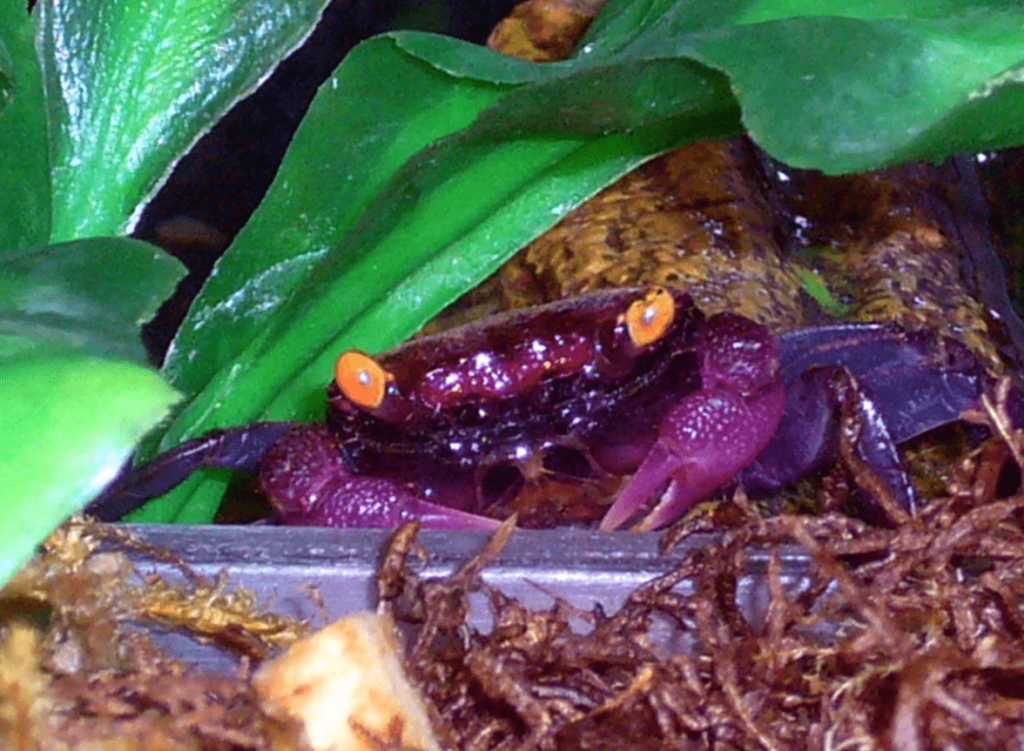The charming and beautiful freshwater crustaceans known as vampire crabs (Geosesarma spp.) are renowned for their bright colors and unusual habits. These crabs, which originate from forest streams and river banks in Southeast Asia, especially in Indonesia. They are popular in the aquarium trade due to their attractive appearance and manageable size. Everything you need to know about vampire crabs Including habitat, behavior, tank setup, food, and care.
Table of Contents
Vampire Crab Natural Habitat and Behavior

In tropical climates, rivers, streams, and freshwater swamps are home to vampire crabs. This crab is a semi-terrestrial animal. This means they need access to water but also spend a lot of time on land. To avoid predators and maintain the humidity levels necessary for survival, they then hide in the forest behind fallen leaves, rocks and logs. Because this is a nocturnal animal. Therefore, vampire crabs are usually busiest at night when they search for food. They are gregarious animals that often live in small colonies. and demonstrating complex activities such as looking out for each other. and mark the region Understanding these innate tendencies is critical to replicating the environment within the cell.
Physical Characteristics
The normal shell size of a vampire crab is 1–2 inches (2.5–5 cm) and its leg span is approximately 3–4 inches (7.5–10 cm). Its name is taken from its bright color. It can be purple, blue, red, yellow, orange, and often has contrasting bright yellow eyes. They are a stunning addition to any aquarium due to their distinctive appearance.
Tank Setup
The reason is that vampire crabs are semi-terrestrial animals. Careful consideration should be given to how to build a suitable home for them. Here are the key elements of a working tank setup:
- Tank size: For small groups (4-6) of vampire crabs, a 10 gallon tank is usually sufficient. The reason is, this crab is a skilled climber and can escape if given the opportunity. The tank lid must be closed tightly.
- Substrate: To create a surface that retains moisture and allows digging. Mix the sand with coconut fiber or peat moss. This mixture mimics natural habitats while helping to maintain desired humidity levels.
- Land and water sections: Make sure the tank has both soil and water sections. This can be done by using dividers or slim media to create gradients. to maintain water quality Water areas should be shallow—about 1–2 inches (2.5–5 cm) deep—and equipped with light filters.
- Hiding Places: Create lots of hiding places with plants. Driftwood and rocks: These components help reduce anxiety and make the crab feel safe.
- Maintain temperature between 24 and 28°C (75 and 82°F) and humidity between 70 and 80%. Hygrometers and thermometers can be used to help you monitor this situation.
Diet and Feeding
Vampire crabs are omnivorous animals. They often eat plant material, insect remains, and small living creatures. in many types of water Their food in the cage should be varied. to ensure they get all the nutrients they need Here’s how to choose the right food:
- Commercial foods: Premium sinking pellets or foods designed specifically for crabs that are nutritious and easy to prepare are good choices.
- Fruit and Vegetables: Serve fruit in moderation, such as apples or bananas. along with blanched greens like spinach, zucchini, and peas
- Source of protein: Occasionally serve protein-rich foods such as brine shrimp, bloodworms, and small pieces of poultry or fish.
- Calcium Supplements: Give them calcium rich foods. Including crushed egg shells or squid bones. For exoskeleton health
To avoid water quality problems Feed your vampire crab once a day. and throw away any uneaten food after 24 hours.
Breeding
However, vampire crabs can be tricky. However vampire crabs can be bred in captivity under the right conditions. The shape of the stomach is a good way to identify between men and women. Males have a narrower V-shaped stomach. while the female has a larger, U-shaped stomach. The following tips can help you breed successfully:
- Provide adequate hiding places: After mating. Women can be aggressive. So make sure there are enough hiding places for them to return to.
- Ideal conditions: Make sure the female has access to land and water. and keeping temperature and humidity levels constant
- Laying eggs and caring for the eggs: The female stores the fertilized eggs under her abdomen until they hatch. It usually takes 3-4 weeks for the eggs to hatch. This is where the environment comes into contact with the small crab.
- Juvenile Care: Provide young animals with a varied diet and plenty of places to hide. If necessary, separate them from adult animals to avoid cannibalism.
Health and Common Issues
Untuk menjaga kesehatan kepiting vampir Lingkungan sekitar harus bersih dan stabil. Masalah umum seperti infeksi jamur dan pembusukan kulit kayu dapat dihindari dengan penggantian air secara teratur. filtrasi yang memadai dan parameter pemantauan, perubahan warna, perilaku aneh dan postur tubuh yang lesu merupakan indikator masalah kesehatan. Jika Anda melihat salah satu dari tanda-tanda ini, isolasi kepiting yang sakit dan konsultasikan dengan dokter hewan atau ahli akuarium berpengetahuan untuk meminta nasihat.
Conclusion
Pet vampire crabs are interesting and fun creatures that thrive in state-of-the-art aquariums that closely resemble their natural environment. The beauty and extraordinary behavior of these amazing creatures can be admired with proper aquarium placement. A wide variety of food and good care Vampire crabs can be a colorful and energetic addition to your home aquarium. If you pay attention to the little things and work for his well-being.